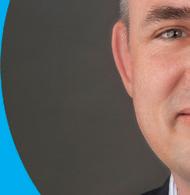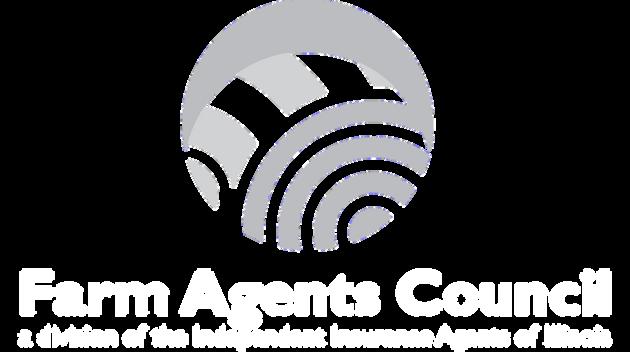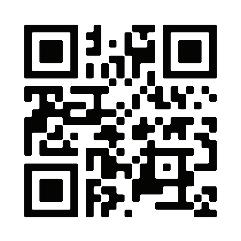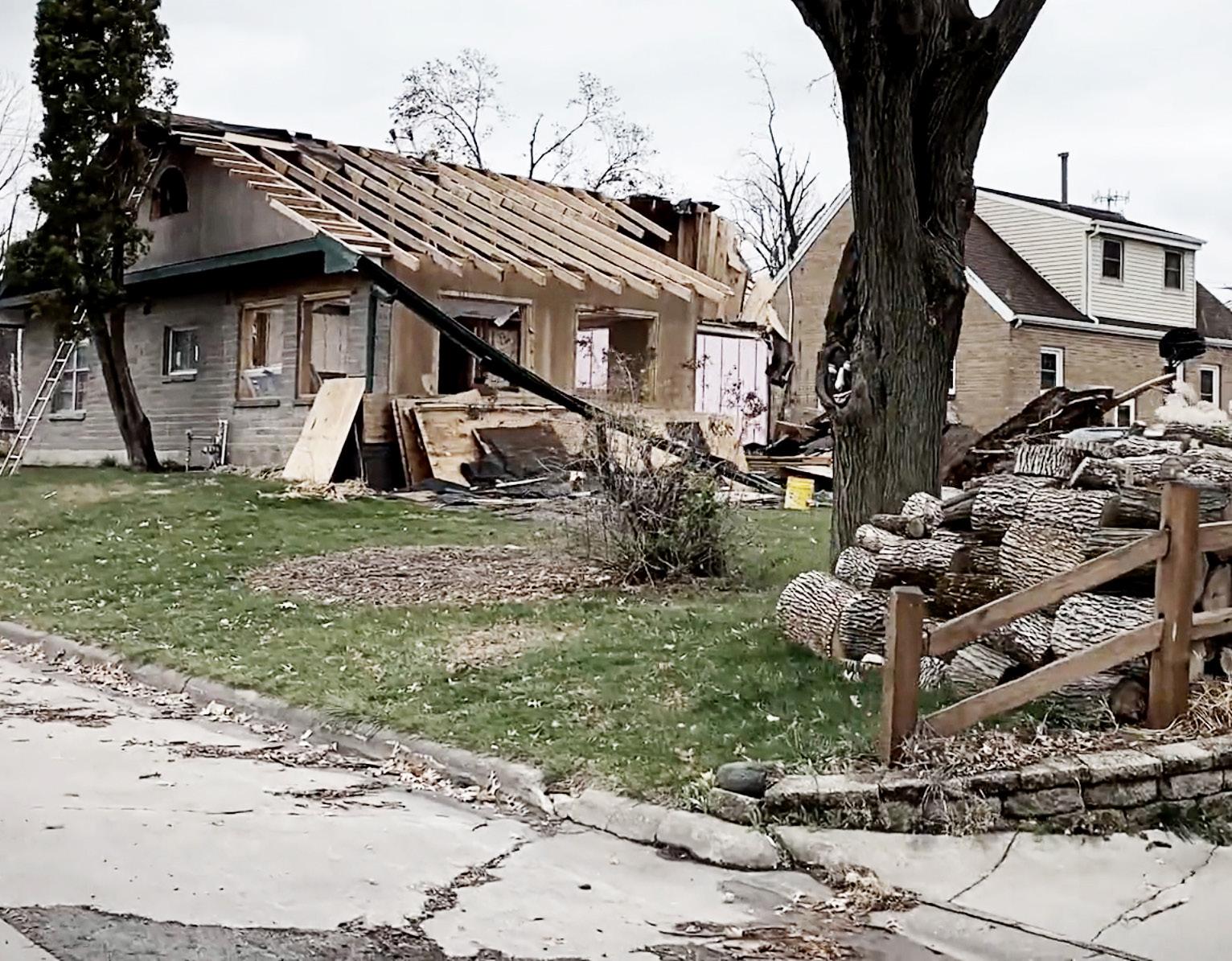








 By Carey Wallce
By Carey Wallce










 By Carey Wallce
By Carey Wallce
Chairman of the Board | Jay Peterson, AFIS, LUTCF (217) 935-6605 | jay@peterson.insurance
President | Kevin Lesch (630) 830-3232 | klesch@arachasgroup.com
President-Elect | Allyson Padilla (618) 393-2195 | allyson@blanksinsurance.com
Vice President | Patrick Taphorn, CIC, CSRM (309) 347-2177 | ptaphorn@unland.com
Secretary/Treasurer | Cindy Jackman, CIC, CISR (800)878-9891 x8745 | cjackman@arlingtonroe.com
IIABA National Director | George Daly (708)845-3311 | george.daly@thehortongroup.com
Region 1 | James Sager (618)322-9891 | james@sagerins.com
Region 2 | Ray Roentz (618)639-2244 | ray.roentz@hwcrins.com
Region 3 | Christopher Leming (217)321-3185 | cleming@troxellins.com
Region 4 | Bart Hartauer, CIC (815)223-1795 | hartauer@hartauer.com
Region 5 | Noele Tatlock (309)642-6855 | ntatlock@unland.com
Region 6 | Thomas Evans, Jr. (779)220-6564 | tevans@crumhalsted.com
Region 7 | David Jenk, Esq. (312)239-2717 | djenk@nwibrokers.com
Region 8 | Charles Hruska (708)798-5700 | chas@hruskains.com
Region 9 | Lindsey Polzin (630)513-6600 | lpolzin@presidiogrp.com
Region 10 | Mohammed Ali CS (847)847-2126 | mali@aliminsurance.com
At-Large Director | Amiri Curry (847)797-5700 | acurry@assuranceagency.com
At-Large Director | Jeff McMillan (815)265-4037 | jeff@mcmillanins.com
At-Large Director | Patrick Muldowney (312)595-7192 | patrick.muldowney@alliant.com
At-Large Director | Luke Sandrock, CIC (815)772-2793 | lsandrock@2cornerstone.com
Budget & Finance | Cindy Jackman, CIC, CISR (800)878-9891 x8745 | cjackman@arlingtonroe.com
Education | Lisa Lukens (618)942-2556 | salibainsurance@gmail.com
Farm Agents Council | Steve Foster (217)965-4663 | s.foster@ciagonline.com
Government Relations | Dustin Peterson (217)935-6605 | dustin@peterson.insurance
Planning & Coordination | Nick Gunn, CIC (309)691-1300 | nickgunn@nixonagency.com
Technology | Brian Ogden (217)632-2206 | brian@ogdeninsurance.com


Young Agents | Renee Crissie (224)217-6577 | renee@crissieins.com
Director of Information and Technology Shannon Churchill - (217) 321-3004 - schurchill@iiaofil.org

Director of Education and Agency Resources Brett Gerger, CIC - (217) 321-3006 - bgerger@iiaofil.org
Accounting & Admin Services Tami Hubbell, CIC - (217) 321-3016 - thubbell@iiaofil.org

Director of Human Resources, Board Admin Jennifer Jacobs, SHRM-CP - (217) 321-3013 - jjacobs@iiaofil.org
Sr. Vice President/Chief Financial Officer Mark Kuchar - (217) 321-3015 - mkuchar@iiaofil.org
Chief Executive Officer Phil Lackman, IOM - (217) 321-3005 - plackman@iiaofil.org
Central/Southern Marketing Representative Lori Mahorney, CISR Elite - (217) 415-7550 - lmahorney@iiaofil.org
Director of Government Relations Evan Manning - (217) 321-3002 - emanning@iiaofil.org
Office Administrator Kristi Osmond, CISR - (217) 321-3007 - kosmond@iiaofil.org
Director of Communications Rachel Romines - (217) 321-3024 - rromines@iiaofil.org
Director of Membership Services Tom Ross, CRIS, CPIA - (217) 321-3003 - tross@iiaofil.org
Products & Services Administrator Janet White, CISR - (217) 321-3010 - jwhite.indep12@insuremail.net Director of Prof. Liability & Ins. Products Carol Wilson, CPIA - (217) 321-3011 - cwilson.indep12@insuremail.net


I hope everyone had a great holiday and your year is off to a fantastic start. As we begin the new year, our agency is focused on what we feel will be important issues this coming year.



• Hard Market
• Marketing
• Office Culture
(First – I have been asked to reinforce my topic from last month – get out and see your carrier reps)
Our question is whether the market will soften this upcoming year. With the end of the year CAT losses as well as the increase in Replacement Costs and Reinsurance Rates, it doesn’t seem like there will be any relief in the P&C markets. Workers Comp rates continue to drop, but how much longer can that continue? (Sorry can’t be all roses and sunshine)
This year we set a budget for our marketing. In years past, we would just pay as we go. This year we put together a plan and have put together a budget to support it. The plan involves, social media, SEO, and yes “old fashioned marketing” which includes print, billboards and trade shows.
If your office is North of I-80 you may be asking yourself if you should be going back to the office, bringing your staff back to the office or getting rid of your office all together. Our agency is sharing in this dilemma. I believe in collaboration. I believe that insurance, particularly commercial insurance, is an industry that thrives in a collaborative environment. It is difficult to train and development new insurance talent in a work from home
environment. However, I believe it is also important to have the ability to offer a work from home option to your employees – so what is the correct “hybrid” model?

No seriously, I am asking.
Start looking out for your local IIA gatherings invitation to legislative events. Hope to see you soon.
Book of the month, The Work Comp Control Effect: 7 Steps to Increase Profits Through Your Work Comp Program by Stephen Sedlak.
v e r a t h r e e - w e e k p e r i o d , a n d t h e r e i s n o n e e d t o d r i v e i n t h e n a s t y J a n u a r y w e a t h e r ! C h o o s e o n e , t w o , o r t h r e e d a y s ( B E S T V A L U E ) E a c h c l a s s i n s t r u c t o r i s e x t r e m e l y k n o w l e d g e a b l e i n t h e i r f i e l d ( r e p r e s e n t a t i v e s f r o m N C C I a n d F E M A , 2 0 + y e a r S t a t e R e g u l a t o r , a n d m o r e ! ) R e a d t h e s p e a k e r b i o s h e r e P l u s , t h e P F T A s e s s i o n i n c l u d e s E t h i c s C E c r e d i t

Trusted Choice® represents Big “I” Members across the country under one brand, highlighting the value of independent agents to consumers. Representing agents in all 50 states for over 15 years!
Visit trustedchoice.independentagent.com to see how the Trusted Choice brand represents agents like you and can help your business thrive.


At least inflation is at 0, according to our sitting President. In reality, inflation is just one of the things that we, as an industry, currently have to tackle. We also have hard markets and constricting reinsurance markets, all due to various factors. I contend that these types of times separate great agents from good ones. You will know who you are when it comes time for a claim to be paid. It’s that old adage, “You can take a horse to water, but you can’t break their leg so that you can shoot them.” Something like that, right? You can present your clients with what they should do, but ultimately, they may go for the least expensive option, which, in turn, could be bad if Murphy’s law kicks in. If they go the cheapest route and have a claim, they will be the broken-legged horse (symbolically). With people having more and more limited income, it will be tough to convince them that they need to purchase more insurance. Like that old question, “How much liability insurance do I need?” Answer: I will let you know when you have a claim. When times are tough, claims increase, lawsuits increase, amounts sought in those lawsuits increase, and pocketbooks tighten. All bad factors for you, the agent.
We all have to weather this storm, as no one is immune. Serving your clients in lower income brackets will be hard to navigate and provide perceived value. Clients only see your value when it comes time to pay a claim. In their mind, everything is covered 100%.


Inflation, which greatly affects rebuilding costs, is one of the biggest factors you need to consider when insuring property. Does your cost estimator have inflationary aspects built into the program, or are you woefully short in your estimates? There are many factors in this process; does your insurer have guaranteed replacement? Do they have a percentage tied to guaranteed replacement (125%)? Do they have 80% requirement in order to have replacement coverage without penalty? This is one factor separating great agents for good agents. Knowing your companies and their products allows you to better navigate this area. Many companies have addressed this area appropriately, which makes it a little easier.
The hardening market, which makes it harder to find the appropriate insurer at an acceptable price point, is becoming the biggest factor. Hardening Markets are telling inflation to hold their beer. We have seen: Insurers pull products out of entire geographical areas; Wind/hail percentage of schedule “A” deductibles, which I thought only happened in coastal states; 30% + personal lines increases in premiums (very conservative); and increases in claims. These all are due to many factors, change in exposure being one of the biggest. People are driving more after the shutdown was lifted. There are increases in weather damage (not a global warming comment or debate). Claims typically increase in a bad economy, just as Workers’ Compensation claims when there is a labor strike on the horizon. The best way to navigate the hardening market is to increase your options. Whether it be finding new companies to contract with or finding new brokerages to do business with, choices and options increase your ability to find a suitable option for your clients. I am seeing entire markets (Cyber) that might move from admitted to surplus lines paper in order to just be somewhat affordable.
Lastly, the reinsurance market is tightening. This is one of the key factors in telling me how our economy is going. I don’t care what the news says; you only have to look as far as the reinsurance market to know how things are going. In good times, reinsurers can’t have their appetite satisfied. In bad times, reinsurers become downright picky and don’t want to reinsure anything (this is where we are). You can talk employment, GDP, CPI, etc.. Just give me the reinsurance market information, and I will tell you how we are doing. Right now, not so good. I am seeing the mine subsidence market for reinsurance dry up. In the near past, you could find reinsurance above and beyond the $750,000 mine subsidence limit, and now it is extremely difficult, if not impossible.
The economy will correct, and things will get better, but how you navigate these troubling (or as I see it, opportunistic) times will determine what your agency looks like in the future. Don’t try to be the cheapest but learn how to become more valuable and protect your clients while navigating this economic downturn. Providing more options and creative coverage solutions will separate you from your competitors. As the great Ty Webb once said, “Be the ball, Danny.” Immerse yourself in educating yourself about your product coverages and choices. I know it always comes back to education with me. It’s true with any aspect of life as they talk about the 10,000-hour rule. You need to spend 10,000 hours hitting to become the best hitter that you can be, and with insurance, you need to spend 10,000 hours educating yourself to become the best insurance person. Fortunately, those hours can be obtained at www.iiaofil.org/Education (shameless plug).
Should you have any questions regarding this issue, do not hesitate to reach out to me directly.

As always, this is just Brett’s 2 Sense and I hope it was helpful. If you need any clarification or have any suggestions for future articles please email me at bgerger@iiaofil.org.
 Brett Gerger | IIA of IL Director of Education & Agency Resources bgerger@iiaofil.org
Brett Gerger | IIA of IL Director of Education & Agency Resources bgerger@iiaofil.org











A bear market, war in Ukraine and supply chain imbalances are just some of the unforeseen developments that impacted the U.S. and global economies in 2022. But what to expect in 2023?
As the new year approaches, Nationwide Chief Economist Kathy Bostjancic and her team of economists are keeping a close watch on global events and key economic indicators to discern how the economy is likely to develop. In October, Bostjancic succeeded recently retired, former chief economist David Berson. She is the second person and the first woman to be named chief economist at Nationwide. Frequently quoted by national and global business media, she joins Nationwide with both domestic and international economics expertise.
Bostjancic recently discussed the economic outlook for the next six-to-12 months, expectations for the Federal Reserve Open Market Committee, and the likelihood that the U.S. will be in a recession this time next year.
Q: How would you assess where the economy is today?
Bostjancic: The economy is still running at a sturdy pace as the labor market remains strong and consumers dip into pandemic-related savings to fund their spending. However, the economy looks to be in the late part of the business cycle where economic activity is buoyant and resources in the labor and product markets are strained, which leads to heightened inflation pressures. The labor market remains very tight as characterized by a very low unemployment rate, 3.7% in October, and the high number of job openings per unemployed persons, roughly two-toone. While strong labor demand underpins rapid wage increases, wage gains still lag the rate of inflation, leading consumers to dip into their savings and rely more on credit to fund their current consumption.
The persistently high inflation is a consequence of pandemic-related factors that include disrupted supply chains, record amount of fiscal stimulus and extremely easy monetary policy that fueled consumer and business spending. This resulted in aggregate demand far outstripping aggregate supply, pushing the economy further into a late-cycle phase. The outbreak of war in the Ukraine exacerbated supply constraints, especially for food and energy, leading to another leg up in inflation.
Thankfully, an easing in supply chain stresses and a shift away from heavy goods spending towards more services has led to a marked slowing in consumer goods inflation. Commodities less food and energy inflation decelerated to 5.1% in October from the recent peak of 12.3% in February. However, core services inflation, which excludes energy services, has accelerated to a 40-year high of 6.7%. The sharp disinflation in goods prices has allowed the headline consumer price index (CPI) year-over-year rate to cool from the recent peak of 9.1% to 7.7%, while core CPI has decelerated more gradually to 6.3% from the cyclehigh 6.6% in September. Going forward, we look for the
By Nationwidedisinflation in the goods sector to continue, but the more gradual easing in services inflation should keep overall inflation’s improvement gradual.
Q: The Federal Reserve Open Market Committee, led by its Chairman Jerome Powell, has been moving aggressively to raise interest rates to tamp down inflation. Do you expect more rate hikes in the next six months?
The Federal Reserve is resolutely focused on reducing the pace of inflation back towards its 2% target level in the medium-term. As such, policy officials are poised to drive the policy rate to 5.0-5.25% and hold it at that restrictive level through 2023. Additionally, the Fed is shrinking its balance sheet at a target cap of $95 billion per month.
Aggressive Fed tightening has hit the housing market most noticeably since it is the most interest-rate sensitive sector in the economy. With mortgage rates soaring to 7%, the housing market is already in a recession and the sector is a leading indicator for the broader economy.
Beyond housing, higher corporate borrowing rates have soured investors’ sentiment towards technology stocks since they are the most debt-intensive sectors. Consumer borrowing rates for autos and credit cards have also increased, but the large pent-up demand for autos amid still constrained supply supports auto sales. For now, consumers continue to rely on pandemic-related savings to help fund their spending, but as employment demand cools, we expect consumers will be less willing and able to dip into savings by mid-2023.
Q: Are we headed for a recession? And if so, how severe might it be? Looking ahead, we foresee a confluence of factors pushing the economy into a moderate recession starting in mid2023. Elevated inflation, rising interest rates, and the diminished level of excess savings will slow consumer spending. Corporate earnings growth will decline as profit margins compress further and top-line revenue growth slows as consumer spending cools. Corporations will then be forced to curtail hiring and pull back on capital expenditures. The eventual job losses will lead to a contraction in consumer spending, leading the economy into a recession in the second half of 2023. We think it will be a more moderate-sized recession, with a peak-to-trough decline of around 1.6%, versus the average post-WWII average of 2% - excluding the Great Financial Crisis and the latest covid-induced recession.
Buffering the economy from a deeper recession are continued excess pandemic-driven savings, pent-up demand for consumer services and autos, healthy overall consumer and business balance sheets, and the likelihood that inflation cools next year, albeit remaining too hot for the Fed.
This article originally appeared on the Nationwide website at https://news.nationwide.com/2023-economic-outlookkathy-bostjancic/.




On September 8, 2022, AM Best revised its market segment outlook for the U.S. personal auto insurance market from stable to negative. The outlook was based on a significant deterioration in carriers’ results for the second quarter of 2022, which was driven by inflationary pressures and corresponding challenges in rate adequacy.
Personal auto is the largest line of insurance in the U.S., with direct written premiums totaling $261 billion as of March, according to the NAIC 2022 Market Share Report. And with over 228 million licensed drivers in the U.S., according to Statista, the increase in personal auto premiums has begun to ring alarm bells for consumers.
The reason for the increase in premiums? “Nearly all the largest U.S. personal auto insurers reported poor financial results in the second quarter of 2022,” says Mark Friedlander, director, corporate communications, Insurance Information Institute (Triple-I). “Several issues contributed to this trend and are putting upward pressure on policyholder premium rates as insurers’ loss ratios grow.”
“The second quarter of 2022 marked a fourth consecutive period during which the physical damage coverages exhibited upward pressure on losses due to factors such as elevated used-vehicle values, higher repair costs and increased comprehensive claims from catalytic converter thefts,” Friedlander adds. “These and other factors have contributed to a combined ratio for personal auto, which is forecast to be in excess of 105 for year-end 2022—in sharp contrast to the personal auto sector posting a stellar 92.5 combined ratio in 2020, the industry’s best underwriting result in at least 25 years.”
Couple premium rate increases with the fact that the annual cost of vehicle ownership has now surpassed $10,000, driven by the rising cost of fuel, vehicle parts and maintenance, according to an August 2022 report from AAA, and many drivers are trying to understand what is occurring in the market and how they can cut costs.
By Olivia Overman“Inflation is driving up loss costs; we are seeing carriers increasing rates, tightening underwriting guidelines, and some book management is occurring whereby some carriers are limiting new agent appointments and reducing commissions,” says Theresa Breunig-Silbernagel, head of personal lines and transformation, Main Street America Insurance. “We are seeing a hard market.”
All this is in stark contrast to the market in 2020 and 2021 when many auto insurance carriers offered refunds or provided premium credits to personal auto consumers when drivers were forced to cut back on driving because of coronavirus pandemic restrictions.
“At the start of the pandemic, auto insurers—anticipating fewer accidents amid the economic lockdown—gave back approximately $14 billion to policyholders in the form of cash refunds and account credits,” Friedlander says. “While insurers’ personal auto loss ratios fell briefly and sharply in 2020, they have since climbed steadily to exceed prepandemic levels. With more drivers returning to the road in 2022, this loss trend is expected to continue into 2023.”
While the average yearly auto premium in 2019 was $1,400, in 2022, the average annual rate hit $1,648, a 17.7% increase, according to a recent report from Insurify. The report also predicts insureds could see an additional 12% increase in premiums, an average of $1,846 for coverage, in 2023.

Is there any light at the end of the tunnel for personal auto consumers?
“Inflation and economic pressures are increasing severity, the cost of repairs and replacement vehicles are much higher than what they have been historically, and repair times take longer and labor costs are up,” BreunigSilbernagel adds. “We don’t anticipate a turnaround in the near future: Even when inflation does subside and rates begin to stabilize, they will not return to levels that we have seen even six months to a year ago.”
Olivia Overman is IA magazine content editor.







Note from the author: The following is a blog post adapted from an article I wrote in 2012 which, itself, was updated from an article I wrote in the mid ‘90s. IF the P&C insurance industry is really headed into a hard market, I think you’ll find this information invaluable. If not, the information should still be of value.
Many people in the P&C industry, particularly agency CSR’s and a number of producers have not yet had the ‘pleasure’ of experiencing a hard market. Some pundits claim we are entering a hard market. That remains to be seen but, if true, a hard market presents a number of selling problems. On the other hand, it also presents opportunities. Below are 12 tips that might improve your sales results in a hard (or any) market.
The very first article I ever published was in the December 1981 CPCU Journal called “The Underwriting Cycle and Investment Income.” If you want a ‘brilliant’ historical analysis of underwriting cycles, click the link to download a PDF of the article, then keep it at arm’s length on your bedroom nightstand…if you know what I mean. That being said, hardcore insurance nerds might actually find the article interesting, at least from an historical perspective.
Historically, a hard market is part of the cyclical nature of the insurance industry. Believe it or not, at one time, the P&C industry experienced fairly regular seven-year cycles of soft and hard markets, tempered or exacerbated, by investment results. However, the last really significant hard market was probably in the mid-80’s.
A hard market is characterized by increasing rates and/or reduced industry capacity which leads to affordability and/ or availability problems. In addition, both underwriting and claims adjusting usually become more stringent. In the current marketplace, these conditions are exacerbated by increased uncertainty about loss exposures from cyber to terrorism, etc.
A hard market presents problems and opportunities. The bad news is that competition could lead to lost accounts. The good news is that competition could lead to lost accounts! That is, it is probably not desirable to retain all existing accounts…more on this later.
And there is more potentially good news…since many carriers are in the same boat, the hard market could lead to new business. In addition, increased premiums means increased commissions (until or unless carriers start reducing them again)…you can use this increased revenue to improve and expand services in a way that differentiates you from the competition.
So, let’s take a look at 12 tips you can use to improve your sales performance during the hard market.
Whether you’re selling BOP’s or Tupperware, you can really only sell four things: (1) price, (2) product, (3) service, and (4) relationship. When it comes to insurance, about 50% of customers are relationship buyers, 25% are price buyers, and 25% buy on the basis of product (10%) or value (15%). Everyone expects competent, if not outstanding, service. If you know where your prospect/ insured falls, you can tailor your proposal to them.
• Develop a client profile/rating sheet…include everything you know about that buyer down to their favorite TV show. I met with an accountant once and, during our meeting, he apologized that he had to take a call, but I could stay where I was. It was a customer of his and, just before picking up the phone, he brought the customer
file up on his PC. Included in the customer’s profile was all kinds of personal information, from family member names and birthdays to hobbies and comments he noted from past meetings. By mentioning things like Little Bobby’s birthday coming up on a couple of weeks, he took the opportunity to strengthen the customer relationship on a personal “Wow, this guy remembered my kid’s birthday!” level.
• Identify the real decision makers…you cannot sell insurance if you’re going through a gatekeeper.
• Learn all you can about the buyer…talk to employees, business associates and others to learn what makes that person “tick.”
• Stay in frequent contact…communicate with VIP, atrisk, and high potential customers frequently and rarely should the contact concern their insurance account. Avoiding the perception that the only reason you’re making contact is to sell something is important to building the relationship. Devote 20% of your time to relationship building.
• Pay attention to the little things…Joe Girard, listed by the Guinness Book of World Records as the best car salesman in the world, said his secret was greeting cards…sending birthday, holiday and other greetings. So, keep in contact and do little things throughout the year for clients (e.g., email a magazine article on a subject you know they’re interested in) and do something really memorable shortly before renewal time that’s unrelated to their insurance account. Don’t use only your cell phone or email to communicate…getting personal snail mail and hand-written notes increasingly has impact.
According to Guerilla Prospecting, many contacts with fewer customers is better than fewer contacts with many customers:
• 1 sales contact = 2% of sales closed
• 2 sales contacts = 3% of sales closed
• 3 sales contacts = 4% of sales closed
• 4 sales contacts = 10% of sales closed
• 5 sales contacts = 81% of sales closed
Industry consultant Chris Burand once told me that perhaps the #1 time waster for producers is the failure to qualify prospects. But, once you’ve identified quality prospects, don’t let initial pushbacks stop you. According to the Darnell Corporation, 80% of sales are made by 20% of sales people. Over 50% of all of Avon’s sales come from 17% of their sales reps…those reps produce 10x the revenue of others. The reason for this is that most sales people quit after one or two initial contacts:
• 48% quit after the first contact
• 25% quit after the second contact
• 12% quit after the third contact
• 5% quit after the fourth contact
• 10% quit after the fifth contact
As you can see from the Guerilla Prospecting figures above, 80% of sales require at least five contacts.
The following statements all mean “No.” However, as pointed out above, don’t take “No” for answer…it may take 4-5 “No’s” until you get a “Yes.”
• “I’ll think it over.”
• “We’ll discuss it and let you know.”
• “I’m just looking at all my options.”
• “The price is just too high.”
• “I’ll have to get back to you.”
• “Let me see how this fits our budget.”
Source: “Six Rules of Salesmanship to Clinch the Deal,” Home Office Computing, August 1995
If I said I could come into your agency or company and show you how to close over 90% of your sales leads, increase your retention rate to 99.9%, and more than double your book of business in less than a year, would you hire me as a sales consultant? You would?! That’s odd because notice that I’ve made no mention of what I’d charge you for this service. ! When you offer solutions – to create opportunities, solve problems, reduce risk, etc. – price is the last thing that will come up during the negotiations.
Let’s face it, most insurance is sold the same way… similar approaches, similar coverages (in the minds of the prospects), similar proposals, claims, promises, etc. All these things being (perceived as) equal, the ONLY
differentiation is price. You must determine what is your “unique selling proposition,” what differentiates you from the masses.
Tim Wahl is an independent commercial lines agent in Missouri. He tells me how often a prospect such as a contractor comes into his office wanting him to “save me money.” Invariably, desirable prospects leave as customers paying MORE than they were paying before. One of the reasons for this is that Tim, as a coverage expert, is able to show the prospect all of the holes in his insurance program and how Tim can fill those holes for little additional premium. He’s selling value, not price.
Consider offering a package of solutions unlike anything offered by your competition. Consider free, discounted or in-house seminars, loss control services, or other perks… with increased commissions, you may be able to offer these perks essentially for free.

With regard to acquiring accounts during the hard market, the best prospects are those experiencing problems with their current insurance program…and you can relieve their pain. If the person is a “product buyer,” you can also create pain by (like Tim Wahl above) showing coverage gaps compared to your products…be sure to use vivid examples. Demonstrate how your proposal positively affects their bottom line by reducing risk and providing that proverbial “quiet night’s sleep.”
My personal lines account has been with the same agency for 45 years. They don’t always offer the best “product” and I can likely get a better price elsewhere. If you read Tip #1, you know, then, that they probably retain my account based on our relationship.
My mother worked for this agency for a number of years until she became terminally ill and passed away 40 years ago. During her final year, she was only able to work a few weeks out of that year. At best, one could expect, given a decent insurance package, that she’d get 60% pay under a salary continuance or LTD program. However, the agency owner continued to issue her full paycheck every two weeks whether she was able to work or not.
When the call came from the hospital that she had only hours to live, I raced there at 2:00 a.m., just before she passed away. At 3:00 a.m., the agency owner and his wife showed up at the hospital to offer any help they could. I’ve never forgotten what they did for my family and, for that reason, I’ve never considered moving my account to save a few bucks. If you want to read more about this story, check out my blog post entitled “How do You Create Customer Loyalty? Why Do Consumers Stay with a Particular Agent or Carrier for Years?”
(https://tinyurl.com/WilsonCustomerLoyalty)
Relationships create loyalty. Strong relationships based on genuine interest, empathy and compassion create fierce, almost fanatical, loyalty. If you treat your customers like family and, when the need arises, you go beyond the call of duty, no coverage perks or pricing discounts can approach the effectiveness of such relationships.
Include testimonials of long-term clients in your marketing materials. Every time you’re involved in a claim “victory” for an insured, ask for a testimonial. Every time you exceed the service expectations of a customer, ask for a testimonial. Target these testimonials so that recipients of your materials know the persons if possible. Flaunt the fact that so-and-so chose your agency or company over that of other competitors. If needed, ask a respected client to make a personal call to a customer on the fence…prospects will appreciate your personal interest and value the opinions of a peer.
There are dozens of closing techniques that you can use and you can learn all about them if you attend a formal sales training program. You can incorporate more than one technique in an attempt to close the account. For example:
• Direct close…simply ask for the account.
• Time-driven close…rates are going up next week, so buy now.
• Relationship close…as indicated above, this is a foolproof method.
• Deal/concession close…but wait, there’s more! At each balk, up the ante by adding freebies like discounted seminars, loss control services, etc.
Provide consistent, personalized, responsive, reliable, accurate and professional customer service. Do the unexpected to dazzle them with your commitment to service excellence. For a good article on this, check out my
blog post “Puttin’ on the Ritz…Building a Customer Service Culture.” (https://tinyurl.com/WilsonRitz ) Also check out the book “The Southwest Airlines Way: Using the Power of Relationships to Build High Performance.”
Entire books and seminars have been devoted to this subject. Some objections are real and must be addressed while others may mask hidden agendas. Objections, in and of themselves, are not bad. According to Learning International, you are 20% more likely to close a sale that includes objections than if the prospect or insured raised none at all.
To minimize objections, sell the benefits, not the product… focus on emotional (e.g., security/risk concerns) or financial (e.g., cost reductions) benefits. Focus on why they should buy, not their objections. Anticipate and be prepared for objections.
Avoid bringing up objections that the prospect would not have raised…e.g., don’t start out the proposal with, “I know the price is a lot higher than last year, but…[add excuses here].” Avoid the discussion of price until after you’ve demonstrated the superiority of your proposal and never make excuses.

The Prayer of Alcoholics Anonymous says, “Lord, give me the courage to change the things which can and ought to be changed, the serenity to accept the things which cannot be changed, and the wisdom to know the difference.” This prayer could apply to three major types of objections:
• Sincere objections…you can negotiate around these.
• Hopeless objections…you got to know when to hold ’em, and fold ’em.
• “Smoke screen” objections…as pointed out above, these have nothing to do with the product, but rather mask a hidden agenda…fix that problem and you’ve got the account.
One other thing to keep in mind, particularly if you further your learning by attending a sales training program, is to remember that you’re often selling to a sales person. In many cases, they’ve seen all the canned sales tactics.
In closing (no pun intended), view a hard market not as an impediment to sales success, but as an opportunity to acquire accounts from people who have not read this article.
Bill Wilson is the founder of InsuranceCommentary.com. He is one of the premier insurance educators in America on form, coverage, and technical issues; founder and director of the Big “I” Virtual University; retired Assoc. VP of Education and Research from Independent Insurance Agents & Brokers of America.
When it comes to insuring your clients’ jewelry, often a standalone, specialty jewelry insurance policy provides the best option for protection. That’s why Big “I” Markets has partnered with Jewelers Mutual to bring a fast and easy solution for this market to Big “I” members.
Big “I” Markets agents can quickly quote through our direct portal located at jewelry.bigimarkets.com. Many policies are issued at the point of sale without a need for underwriting review, and policies protect against loss, theft, damage, and mysterious disappearance.
As always, there are no fees, no production minimums, and you own your expirations. Visit Big “I” Markets’ dedicated jewelry portal at www.jewelry.bigimarkets.com. In order to receive commission, you must also request a quote in Big “I” Markets.

A hard market is a term used in the insurance industry to describe a period of time when insurance premiums are generally increasing, and underwriting standards are becoming more stringent. A hard market may be the result of a variety of factors, including increased claims and losses, rising costs for insurance companies, and increased regulation. In this environment, an independent insurance agency’s profitability may be impacted in several ways. That impact can be positive for some agencies and negative for others based on how well an agency responds to their customer’s needs.
During a hard market, insurance companies may experience increased commission and fee revenue provided that their customers can withstand the rate increases. This can also occur due to their customers incurring higher claims and losses, which can lead to higher premiums for policyholders. As a result of these increased premiums, independent insurance agencies may find it more difficult to sell policies to potential customers and retain their current customers as the higher premiums may be less affordable for some consumers. This can lead to lower sales and retention revenue for the agency.
Additionally, during a hard market, insurance companies may also be more selective about the risks they are willing to cover, which can result in a decrease in the number of policies that are available to sell. This can also lead to lower sales and revenue for the agency. Independent insurance agencies may also face increased competition from other agencies as they try to win business in a challenging market. This can lead to lower profit margins for the agency. There are several things that independent insurance agencies can do to minimize the impact of a hard market on their agency:

1. Focus on providing excellent customer service: Providing outstanding customer service can help to retain existing clients and attract new ones, even in a challenging market.
2. Build and execute a strong retention strategy: Communicate clearly to your current customers about the market conditions and be proactive in your approach. This is a time when your advice and guidance are key to building a strong relationship with your customers.
3. Diversify the types of insurance products offered: Offering a variety of insurance products can help to mitigate the impact of a hard market in any one
By Carey Wallacespecific area. For example, if one type of insurance is experiencing higher premiums due to increased claims, the agency may be able to offset this impact by selling more policies in a different area where premiums are stable or even decreasing.
4. Develop a strong digital presence: In today’s world, having a strong presence online is essential for businesses of all types, including insurance agencies. By improving your website, maintaining an active social media presence, and using digital marketing techniques, agencies can reach new customers and expand their reach.
5. Look for opportunities to save money: In a hard market, it may be necessary to look for ways to reduce expenses in order to maintain profitability. This could include negotiating lower rates with suppliers, finding more costeffective ways to advertise, or streamlining operations to reduce inefficiencies. Investments in your agency’s efficiency are key, and those agencies that have made these investments will be well-positioned to perform well in a hard market situation.
6. Consider joining a network: By joining a network an agency can expand the range of products and services offered and increase the number of customers they can serve.
By implementing these strategies, independent insurance agencies can minimize the potential negative impacts of a hard market and continue to operate successfully. Agencies that anticipate and prepare for the changing insurance environment are able to be better equipped to meet the needs of their customers.

By simply having the infrastructure, procedures, and foresight to be proactive they will be able to outperform agencies that continue to operate the way they always have. The ability to be nimble and adjust as the market conditions change will be appreciated by their customers and will serve agencies well in a hard market.
Carey Wallace is the founder of AgencyFocus, an independent insurance agency consulting organization. She has worked in the insurance industry for the last 12 years and with entrepreneurial small businesses for her entire career. During that time, she developed key business consulting services to ensure that agencies have the information and support they need to plan for their agency and successfully perpetuate to the next generation. Find out more at agency-focus.com.
The old way of selling insurance is dead. We don’t use the yellow pages as a prospecting tool. We don’t show up at a client’s home in a suit with a briefcase. We don’t fax our clients their proposals.
The problem is our industry is still trying to sell insurance like the “old days”!

Producers who are serious about building their book of business are looking for new, innovative ways to stand out in their marketplace. They want to break out of the “stale insurance salesperson” stigma and provide modern solutions to their prospects and clients.
The Protégé Sales Bootcamp is designed to teach new and experienced sales professionals how to use modern tactics to stand out and win business. During the course, Derek shares the secrets that helped him lead The Protégé competition in sales and ultimately win the reality show. You’ll learn how you can use those same tactics to write more business in 2023 and beyond. You’ll leave the bootcamp with a refreshing new outlook on how to succeed in insurance sales.
By now you’ve probably seen the reports about some of our insurance marketplace trends.
InsuranceNewsNet reports that for carriers “…capacity is definitely tightening”.1
AM Best revised its market segment outlook for the personal auto insurance market from stable to negative.2
Moody’s Investors Service has changed their outlook for the global property/casualty sector from stable to negative.3
We could go on, but what does this all mean for independent insurance agents in Illinois? We think it means opportunity.
When carrier capacity tightens, insureds need options. Independent agents are obviously well-positioned to provide options, even if there are fewer carriers with appetites for certain risks. This is the time to see which of your carrier and wholesale broker relationships you can leverage to give your prospects and insureds the coverage opportunities they need.
The impact of the personal auto insurance market specifically is likely to have the largest impact on direct writers. Their strategy is typically built around advertising and promotion of “savings” on auto insurance. Market changes may directly impact that strategy. Independent agents that have focused more heavily on commercial may have a great opportunity to cross-sell clients on personal lines when dissatisfaction grows with direct writers.
While Moody’s feels the overall insurance marketplace may tend downward, they believe the U.S. commercial insurance sector will remain stable. One of the biggest reasons independent agencies have weathered so many economic storms is the diversity of their books of business.
If we do see major personal lines impacts in the next 12-18 months, focus on leveraging more opportunities on your commercial lines business to offset them. For example, put additional resources into account-rounding, develop additional prospecting tools, and invest in commercial lines education for your team.
In addition to these responses, consider using any market “difficulties” as a chance to set your agency apart. We talk all the time about how independent agents provide more than just price, so let’s lean into that. If it fits your client objectives, position your marketing to show that your agency can help people develop real risk management solutions. Talk about how this is the time where options and solutions really shine, as opposed to price-shopping and quick quoting.
Independent agents have the knowledge and resources to turn economic impacts into opportunities. Harness your competitive advantages and deploy them as ways to grow if the marketplace takes a turn. We’re confident you’ll come out even stronger on the other side.
Daniel Smith, CAE, is the Chief Marketing Officer and co-founder of Market Retrievers, a digital marketing firm focused on building and implementing strategies for independent insurance agencies. He previously worked for the independent agents association in Tennessee for over 14 years and served as the CMO and COO. He is also a licensed P&C agent. He may be reached at dsmith@ marketretrievers.com.
1https://www.iamagazine.com/markets/why-is-thepersonal-auto-market-deteriorating

2https://insurancenewsnet.com/innarticle/reinsurancecapacity-are-concerns-following-rising-storm-damageinflation
3https://www.insurancejournal.com/news/ national/2022/12/06/697839.htm
I’ll begin by saying my answer to this question is an emphatic YES! A week before Thanksgiving it happened again; as it does every year since I began in sales in 1987. I overheard a salesperson say, “Yeah, well, we only have a couple days next week and then of course everyone pretty much takes off the rest of the year, with the holidays coming, so I’ll probably wrap up my prospecting for the year this week.”
This, along with salespeople ducking out at noon of Fridays, are my biggest triggers; they get me on my soapbox immediately. For me, it’s worse that fingernails down a chalkboard. There are a number of reasons why, here they are.
First, regarding the end-of-the-year holidays, no prospect or client takes off the entire last six weeks of the year. Zero. Okay, maybe one in one hundred million. Yes, most take some time, a few days to as much as a week or two, but not Thanksgiving week, the rest of November, and all of December.
Some quick math: If you slack off the last six weeks of the year, you’re missing almost 12% of the entire selling year. That’s a lot of selling time and will absolutely negatively affect your sales numbers.
The laws of physics apply to sales: a salesperson at rest tends to stay at rest, one in motion tends to stay in motion. If you sit still for the last six weeks of the year, good luck hitting the ground running at the beginning of the year. It’s going to take some time to get up to speed and back in a groove. The beginning of the year is when you want the most momentum, not the least. Get behind early in the year and you’re likely to be stressed and find yourself behind the eight ball.
This is the same reason I tell salespeople to do at least some cold calling every day you’re working. Like anything you want to get good at and make a habit, the most important aspect is consistency. The more you do something on consecutive days, the faster you’ll learn and the more it stays with you. If you only cold call on Wednesdays, you’ll fall out of practice Thursday through Tuesday so that when Wednesday rolls back around, you’ll once again feel the law of physics, not only will it be tough to get moving, but you’ll also be rusty due to the amount of time off.
Let’s talk about the other time when salespeople like to ‘take it easy’ and make few to zero calls: Friday afternoons. I’ve heard a number of reasons for this but this usually comes down to the salesperson looking forward to ending

the work week early and settling in to the weekend. I’ve heard some salespeople say something along the lines of, “People don’t want to hear from a salesperson Friday afternoon; they are busy wrapping up their week and they just want to get out of the office as quickly as possible.” Like most other excuses for not making calls, this one sounds good and logical, but is wrong. Serious businesspeople and executives aren’t focused on the weekend when they’re at work and they certainly aren’t trying to cut out of work early. Personally, I believe the reason for a lack of calls is the former reason: the salesperson wants to stop working and start the weekend early, versus the latter: that people don’t want to talk to them. Real businesspeople like to talk to people who can help them and their business and give them a competitive edge.
Now, some more quick math. If you skip Friday afternoons, you essentially miss 10% of a five-day work week. Combine that with taking off the last six weeks of the year and now you’re down 22%. So, now you have 78% of the time to hit 100% of quota, or hopefully more.
All of the above said, what are the advantages of calling people Friday afternoons and around the holidays, including the days before and after Thanksgiving, December 24th, and December 31st? The first advantage is that people usually have more time to talk to you. Things do slow down a bit and people who would be trying to get the prospect’s attention at other times of the year and week, including competitive salespeople, aren’t calling on them because most people make excuses to relax and not work at these times. Next, people are generally in a better mood on Friday afternoons and around the holidays. Finally, you’ll stand out from the other lazy and unmotivated salespeople who take off early on Fridays and don’t make calls on and around holidays. As a side note, I made one of the biggest sales I ever made in 35 years, into a competitive account, at a little after 3 p.m. on December 31st. I can’t tell you how many sales I’ve closed at Christmas, Fourth of July, and other holiday parties, and on Friday afternoons, but it’s been A LOT.
Here’s a rule I follow regarding holidays and other days off: if your customers are open for business, you’re open for business. Just because your company is closed the Friday after Thanksgiving, or on the 5th of July because July 4th was on a Sunday, doesn’t mean your customers’ businesses aren’t open. If they’re open, you’re taking and making calls.
John Chapin is a motivational sales speaker, coach, and trainer with 35+ years’ experience. Go to www.completeselling.com for more information.
IMT Insurance was honored to participate in Giving Tuesday on November 29, 2022. Giving Tuesday is a global day of giving that harnesses the collective power of a unique blend of partners – charities, families, businesses, and individuals – to encourage philanthropy and to celebrate generosity worldwide. Giving Tuesday is held annually on the Tuesday after Thanksgiving.
IMT strives to support local communities, throughout our six-state writing territory, in an impactful way. On Tuesday, November 29, 2022, one $2,500 donation was pledged every hour from 9 AM – 4 PM, for a total of $20,000! Six of the organizations were selected from the 2022 IMT Community Contest program winners, and the final two were selected by IMT employees.
The following Illinois organization received $2,500 as part of IMT’s Giving Tuesday participation: City of Galena (Galena, IL).
Columbia Insurance Group has named Lisa Wharton Vice President and Chief Information Officer. She will be responsible for planning, directing and coordinating the Information Technology Department in support of the company’s strategic objectives.
Wharton is an accomplished technology leader with over 20 years’ experience in the insurance and financial services industry providing technology strategic direction in developing long-range IT portfolio planning. Throughout her career, she has played key roles in the implementation of innovative business, development, and operations solutions while creating an engaged culture and environment.
Rockford Mutual Insurance Company (RMIC) looks to recognize an exceptional associate every year with our Associate of the Year Award. Our Agency Assistant, Kristin Gonzalez, is RMIC’s 2022 recipient!
Kristin joined Rockford Mutual in 2016 after several years with Liberty Mutual. She is a licensed insurance producer for the state of Illinois and has earned her Certified Insurance Service Representative (CISR) designation. Kristin has done excellent work as the Agency Assistant for Rockford Mutual over the last several years.
Peers note Kristin’s intense determination throughout 2022. She learned many new processes, took on a variety of new responsibilities and excelled in maintaining efficiency within Rockford Insurance Agency, Inc. We would like to congratulate her on being named our 2022 Associate of the Year and thank her for being part of what makes Rockford Mutual a successful regional insurer.
SECURA Insurance will donate $39,000 to 13 nonprofit organizations through the SECURA Gives Back contest, which is designed to help independent insurance agencies support organizations in their communities.
More than 340 agents nominated nonprofits through the SECURA Gives Back contest. This year, 13 agencies were randomly selected to win a $3,000 donation each for a nonprofit of their choice. Since 2017, a total of $171,500 has been donated to 65 nonprofits through SECURA Gives Back.
“We are honored to give back to the organizations that make our communities a great place to live, work, and play,” said Mike Campbell, SECURA Insurance Director –Specialty Lines Underwriting. “This campaign is our way of saying thank you to our agents for all the work they do with us and within their communities. Not only do our agents and associates volunteer with nonprofits, but we also offer insurance coverages designed to protect nonprofit organizations from the unique risks they face.”
The winning Illinois agency and the nonprofit benefiting from the 2022 SECURA Gives Back contest are:
Midwest Insurance Agency Incorporated benefiting Big Brothers Big Sisters of McHenry County
For additional information about the company’s charitable giving and community support, visit secura.net/community.
SECURA Insurance is proud to be certified by Great Place to Work® for the seventh year in a row. This certification is based entirely on what employees say about their experience working at SECURA, which is collected through an anonymous survey. This year, 96% of employees said it is a great place to work – 39 points higher than the average U.S. company.
SECURA’s Great Place to Work survey results ranked the company’s strengths and evaluated employee feedback on areas of leadership, fairness, rewards, and career opportunities. The results showed 97% of employees are proud to tell others they work at SECURA, 98% say when joining the company employees are made to feel welcome, and 98% say SECURA’s facilities contribute to a good working environment.
This certification qualifies SECURA to be named on other Great Place to Work and Fortune Best Workplaces lists. In 2022, SECURA was ranked number 14 on the Fortune Best Workplaces in Financial Services & Insurance for small and medium companies list, number 78 on the Fortune Best Medium Workplaces list, and number 66 on the Best Workplaces for Millennials for small and medium companies list. A summary of SECURA’s Great Place to Work ratings can be found at https://www. greatplacetowork.com/certified-company/5003080.
AMERISAFE
AmTrust North America
Auto-Owners Insurance Co.
Badger Mutual Insurance Company
AAA Insurance Arlington/Roe BlueCross/Blue Shield of IL Grinnell Mutual Reinsurance Company
Keystone Insurance Group, Inc. Pekin Insurance
Imperial PFS
IMT Insurance
SECURA Insurance West Bend Mutual Insurance Co.
J M Wilson
Liberty Mutual/Safeco Insurance
Madison Mutual Insurance Company
Berkshire Hathaway Guard Insurance Companies
BluSky Restoration Contractors
Central Illinois Mutual Insurance Company
Chubb
ClickVSC
Columbia Insurance Group
Continental Western Group
Cornerstone National Insurance Company
Cowbell Cyber
CRC Group
CRDN of Chicago (formerly Restoronics)
Donald Gaddis Company, Inc.
Donegal Insurance Group
EMC Insurance
Encova Insurance

Erie Insurance Group
Family Financial Solutions Group
Foremost Choice Property & Casualty
Forreston Mutual Insurance Company
Frankenmuth Insurance
Grange Insurance
Homeowners of America Insurance Company
Illinois Mine Subsidence Ins. Fund
Illinois Public Risk Fund
Indiana Farmers Insurance
Insurance Program Managers Group
Main Street America Insurance Marble Box MarshBerry
Maximum Independent Brokerage, LLC Mercury Insurance Group Method Workers Comp Midwest Insurance Company Nationwide NHRMA Mutual Workers’ Compensation
Pouch Insurance
Previsor Insurance & Missouri Employers Mutual PuroClean Emergency Restoration Services Rockford Mutual Insurance Company
RT Specialty - Naperville
Sensa, Inc.
ServiceMaster DSI Society Insurance
SPRISKA - Specialty Risk of America Synergy Select
The McGowan Companies
Travelers
UFG Insurance
UIG - The Agent Agency
Utica National Insurance Group W. A. Schickedanz Agency, Inc./Interstate Risk Placement
Western National Insurance Westfield
The Walter W. Schultz Insurance Agency, celebrating 100 years this month, was established on January 23, 1923, by Walter W Schultz and his father, Charles C. Schultz, for the purpose of offering insurance, real estate, and dry goods. The first office was located at 18100 Torrence Avenue in Oak Glen, Illinois, which later became Lansing, Illinois. In 1930 the dry goods business was phased out and the business moved to its current location at 18119 Torrence Avenue.


In the beginning the office also served as the Oak Glen post office with Walter W. Schultz as the postmaster. Over time the real estate business was discontinued, and in the mid-1950s the post office moved to Hartfield’s Delicatessen so the agency could focus on selling insurance. Today the agency is owned by Walter W. Schultz’s son-in-law, Norman Abbott (who was married to the late Diane Schultz-Abbott), and is run by their daughter, Cheryl Abbott.
The agency has a staff of six, some of whom are full time and others who are part time. They write all lines of business: auto, home, life, health, and business.

“We attribute our longevity to the service we provide our clients and the many families we have served for so many years,” said Cherly Abbott. “We treat each customer as family. We’ve also been blessed with very low staff turnover during all our years in business.”
The agency is currently looking to hire new agents to help grow the book of business and take them into the next century.
The Farm Agents Mid-Winter Education Meeting is the premier event for those in the Illinois farm, agribusiness, and crop insurance to come together for networking, education and an industry specific trade show. This event draws over 100 agents all from all throughout Illinois, to learn about the impacts our industry is facing, legislative changes, and so much more.
Pre-Licensing-Property & Casualty Virtual
Education Symposium - Drone Insurance & Sales Virtual
CIC-Commercial Property Virtual Agent’s E&O: Defenses and Preventions Webinar

Education Symposium - PFTA & Workers’ Comp Virtual
CISR-Commercial Casualty 1 Virtual
Deep Dive Into Agency Ethics Webinar
Education Symposium - Flood & Cyber Virtual
CISR-Agency Operations Virtual
CISR-Commercial Casualty 2 Virtual
(217) 321-3003,

E&O Roadmap to Personal Auto Webinar

Pre-Licensing-Property & Casualty Virtual
E&O Roadmap To Cyber & Privacy Insurance Webinar
E&O Roadmap To Cyber & Privacy Insurance Webinar
CISR-Elements of Risk Management Virtual
Protégé Sales Bootcamp Bloomington
E&O - Roadmap to Policy Analysis Webinar
Pre-Licensing-Life & Health Virtual
Ethical Dilemmas Webinar
E&O Roadmap To Cyber & Privacy Insurance Webinar
E&O Roadmap To Cyber & Privacy Insurance Webinar
E&O: Identity Theft, Red Flags, and Money Laundering Webinar
CISR-Insuring Personal Auto Exposures Virtual
Agent’s E&O: Duties, Best Practices, Operations, Workflows, and Certificates Webinar
27. We hire people from all educational backgrounds. In claims, underwriting or marketing, you might find degrees in business administration, liberal arts, insurance and more. For jobs like accountant, actuary, attorney and computer programmer, specialized degrees in accounting, math, law or computer science are common.
Check out our Field Claim Representative open positions in Illinois and more open position in many states:
https://www.auto-owners.com/about/careeropportunities
17. We are an Independent family-owned agency located in the Chicago area. We are looking to expand through growth and acquisition. If you have a small to medium sized agency and are looking to sell, call or send us a message. We are strictly looking for Personal Lines and Small Commercial accounts with preferred companies.
GALO Insurance Agency, Inc (847) 832-0888 steve@galoagency.com
20. Since 2004, Central Illinois Agents Group LLC has been providing independent agents with a variety of markets with contingency opportunities. Agents have availability to several markets that they may not be able to sustain or maintain on their own. We have markets for personal, commercial, agricultural and crop insurance lines. Let us help you get to the next level.
Visit www.ciagonline.com for contact information.
02. Forest Park/Oak Park agency for over 60 years, will meet your needs by providing space, markets, marketing & sales support, automation, merging with or purchasing your agency. Perpetuation/ Succession Plans, BuySell Agreements also available. We have experienced, educated and dedicated staff for you and your clients. Have access to our numerous companies, office services and many other resources. Retain ownership in your book with contingency. Please look closely at us- we are an agency you want to do business with! We’ve done it before, we know how- we make it easy! Visit our website at forestagency.com/agents.html, or call for a confidential discussion and a list of Agency benefits.
Dan Browne will provide an agency evaluation/appraisal at little cost to you. Please call:

Dan Browne or Cathy Hall
Forest Insurance (708) 383-9000 www.forestinsured.com/mergers-acquisitions
13. We are a 100 year old Northbrook agency looking to discuss any mutually beneficial opportunity. Our producers, mergers, clusters and agency purchases receive 50% commissions on new and renewal business without any expenses. We can provide: office space, phones, agency management system, service renewals and changes. The companies we represent are: Badger Mutual, Employers Mutual, General Casualty, Guide One, Hartford, Kemper, Progressive, Rockford Mutual, Safeco, State Auto, Travelers and Met Life. Contact: Nancy Solomon Martini, Miller & Schloss, Inc. (847) 291-1313 Ron@martini-miller.com

CareerPlug’s hiring software helps agents attract more qualified candidates, identify the right candidates with confidence, and improve hiring results.
CareerPlug will provide IIA of IL members access to a free account that can be used to post jobs, manage applicants, and improve the organizations’ employment brand. Association members can also access a “Pro” version of CareerPlug for a special rate to take hiring to the next level.
Learn more about CareerPlug and check out the brand new IIA of IL job board at www.iiaofil.org
There’s no hocus pocus needed to find the right small business coverage. Think BOP-Pro from UFG Insurance. BOP-Pro helps take the complexity out of small business insurance with more than 35 property and liability coverages. It can even be tailored with coverage boosting endorsements, especially when it comes to the unique needs of restaurants and contractors.
But don’t take our word for it. Check out BOP-Pro products from UFG today. No crystal ball required.

ufginsurance.com/bop-pro

